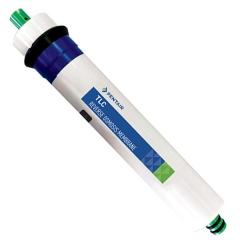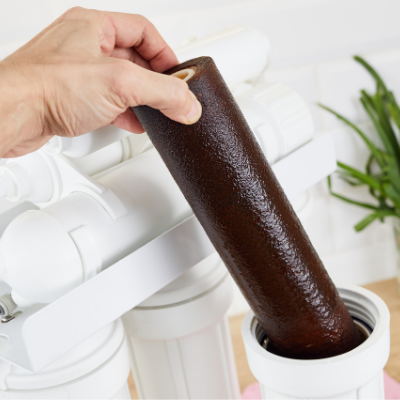Why Reverse Osmosis Water Flow is Slow
Six Reasons Your Reverse Osmosis Water Flow May be Slow
There are various factors that can contribute to slow water flow at your reverse osmosis (RO) faucet. Here are six reasons that can make your under-sink RO water filter drinking water system have slower water production:
CLOGGED RO MEMBRANE
If you forget to change your reverse osmosis membrane, with time your system will produce less and less water. Reverse osmosis membranes are fragile and can become fouled if not changed often. Generally, RO membranes only need to be replaced every 24 months. Trying to fill your water storage tank with a clogged membrane may take 4-6 hours, rather than the usual 2-4 hours. We suggest setting a calendar reminder to buy a reverse osmosis replacement membrane.
with time your system will produce less and less water. Reverse osmosis membranes are fragile and can become fouled if not changed often. Generally, RO membranes only need to be replaced every 24 months. Trying to fill your water storage tank with a clogged membrane may take 4-6 hours, rather than the usual 2-4 hours. We suggest setting a calendar reminder to buy a reverse osmosis replacement membrane.
Find Replacement Filters & Membranes
RUPTURED TANK BLADDER
If you only get about one cup (8 oz) of water out of your RO faucet at normal water pressure, and then the water promptly trickles down to a very small stream, this typically is a sign the air bladder in the storage tank has ruptured. Unfortunately, the air bladder cannot be repaired and the only way to resolve the issue is to replace the storage tank. Replacement tanks can be found here.
LOW RO TANK PRESSURE
Slow water flow rates might be a result of low pressure inside the RO tank. Reverse Osmosis tanks should have pressure of 7 to 8 psi without any water in the tank. To check your pressure, locate the valve (typically covered by a blue plastic cap) on the side of the tank near the bottom. After removing all the water from the tank, use a pressure gauge to determine the pressure in the tank. If low, add air with a pump until you have 7-8 psi. Be careful to only add a small amount of air at a time, as too much pressure can rupture the air bladder.
The RO 132 (SKU TKE-3200W) tank has a generous storage capacity of 4.4 gallons, allowing you to store a significant amount of RO filtered water for your household's needs.
The tank is compatible with various reverse osmosis systems, making it a versatile choice for integration into your existing or future RO setup.
CLOGGED RO FILTERS
Replacing your water filter on schedule is crucial to having healthy, delicious  drinking water. If your RO filtration system is producing water slowly, you probably need to change your carbon block, sediment, or GAC polishing filters. In fact, clogged filters are probably the most common reason for reverse osmosis water flow to be slow. Filters should be changed annually, unless water conditions and contaminants present require more frequent filter changes (like every six months instead of 12).
drinking water. If your RO filtration system is producing water slowly, you probably need to change your carbon block, sediment, or GAC polishing filters. In fact, clogged filters are probably the most common reason for reverse osmosis water flow to be slow. Filters should be changed annually, unless water conditions and contaminants present require more frequent filter changes (like every six months instead of 12).
KINK IN WATER LINE
Make sure there are not any kinks in the water line, which would slow water production. And while you're inspecting your reverse osmosis drinking water system, double check that the water supply line valve is in the fully open position.
LOSS OF WATER PRESSURE
You may have temporary loss of water pressure. An RO system needs a minimum of 40 psi to operate properly, but preferably 60 psi. If all your household faucets seem to have low water pressure, it may be a temporary issue with your local water utility company. If higher water pressure does not resume, report the issue to your local water utility company. You might also want to read up on how to properly maintain your reverse osmosis system.
Is Your Reverse Osmosis System Not Producing Water Fast Enough?
If your reverse osmosis unit seems to be producing less filtered water than it did previously, we outline here a few simple steps to check the current production rate of your RO system.
Follow these 5 Steps to determine how much water your reverse osmosis drinking water system is producing over a 24-hour period, and some suggestions for increasing the flow rate.
How to Determine Water Flow Rate of Your RO System
1. Turn the ball valve off
First, make sure the incoming water line to the Reverse Osmosis system is turned "ON". Then, turn the ball valve on top of the reverse osmosis storage tank to the "OFF" position (generally a 1/4 of a turn).
2. Flip handle to up position
If you have a standard reverse osmosis faucet, flip the handle to the "up" position, so the faucet is now locked into a continually open/flow position. At this time any water in the lines of the system will flow from the faucet.
3. Wait until there is a continual fast drip
After there is no more water in the system lines, you may need to wait 1-5 minutes at which time you will/should get a continual fast drip or very slow flow from the faucet. (NOTE: If you get no flow from the reverse osmosis faucet, the system is not producing water).
This flow rate represents the flow rate the system is producing water and the rate that the reverse osmosis storage tank would be filling if the valve on the storage tank was in the "open" position.
4. Measure How Much Water
Once you have a continual drip or slow flow from the faucet, using a measuring cup, measure how much water drips/flows from the reverse osmosis faucet into the measuring cup for 60 seconds.
5. Do the math
Now it's time to do the math!
- Take the number of ounces your RO system produced in one minute.
- Multiple this number by 1440, which is the number of minutes in a day.
- Divide this number by 128 which is the number of ounces in a gallon.
This number is the amount of water your RO system is producing over a 24 hour period.
If you want an hourly water production rate, simply divide the number by 24.
Example: Within 1 minute your system produces 4 ounces of water. 4 x 1440 (minutes in day)= 5760 (ounces) divide by 128 (ounces in a gallon)= 45 gallons per day. Divide by 24 (hours in day) = 1.875 gallons per hour
Once you understand exactly how much water your RO system is producing and if the system's flow rate has decreased, you can now work to figure out the cause and find a solution.
Again, a decreased flow rate may be caused by clogged filters or a fouled membrane that simply need to be replaced.
Reverse Osmosis Troubleshooting Guide
To troubleshoot a variety of issues relating to your under-sink reverse osmosis system, you may find our RO troubleshooting guide helpful. In this guide, we list a variety of issues, probable causes, and the recommended solution.
For RO systems purchased through espwaterproducts.com, customer support is available Monday through Friday 8 am to 5 pm (Central time) at 877-377-9876. Have your customer number or order number ready.
NOTE: "filter bundles" are a convenient way to take care of annual filter replacements. These annual replacement kits include everything you need for annual filter replacements, and often save you time and money. Find your filter bundle by first identifying your RO system brand/model.
Discover effective solutions to common reverse osmosis (RO) water filtration issues. Our troubleshooting guide provides maitenance tips and answers your RO system questions.





